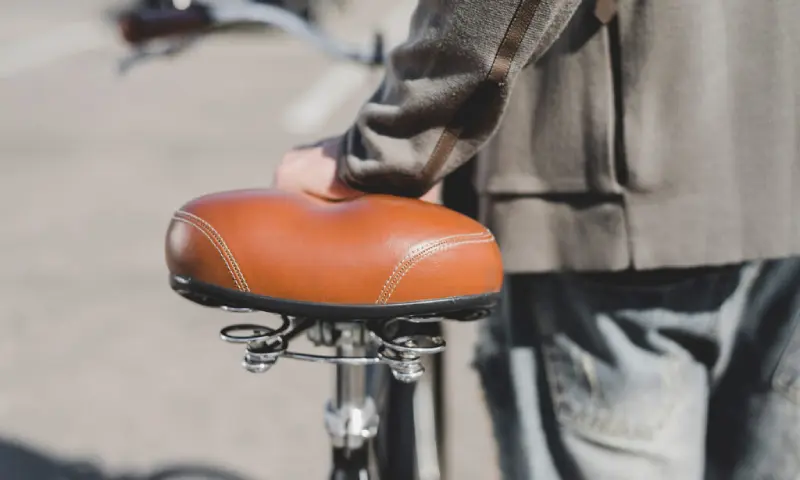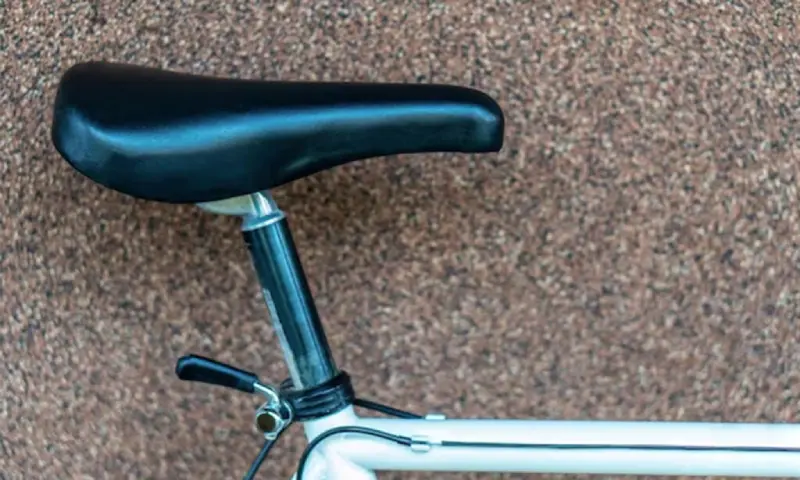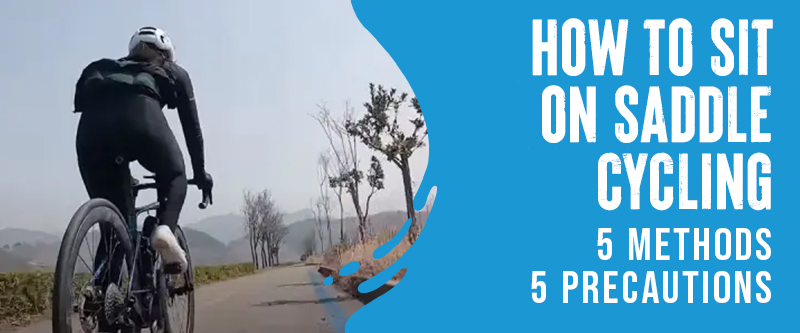A saddle not positioned right can cause knee pain, lower back pain, and nerve damage. These injuries can be severe and may require medical attention. By positioning your saddle correctly, you can reduce the risk of injury and enjoy cycling for years to come.
If you want to sit comfortably on a saddle while cycling, use your sit bones to support your weight. Avoid resting on your pubic bone to prevent fatigue and ensure an upright position.
In this blog post, we’ll explore all the critical elements of seat-on-saddle cycling to help you find the perfect position for your body and bike with its precautions.
How To Sit On Saddle Cycling: 5 Methods

Here are 5 methods to help you master the art of sitting on a saddle. Before we dive into the techniques, we’ll discuss the importance of choosing the right size and type of saddle, covering factors such as width, shape, and material. Plus, we’ll provide step-by-step instructions on adequately positioning yourself on the saddle for optimal comfort.
Bike Saddle Size and Types
To understand how to seat cycle saddles, let’s first discuss the importance of selecting the proper size and style Consider:
- Saddle Width: Your saddle width should match between the sit bones. Sit on a piece of foam or cardboard and measure the space between the two indentations left behind. The width of the saddle varies from 130mm to 155mm. Choosing the correct width will ensure comfort and prevent long rides from being painful.
- Saddle Shape: Different riding styles require different saddle shapes. A road bike saddle, for example, is often longer and narrower for a more aggressive riding position. Mountain bike saddles are broader and padded for greater comfort during rough terrain.
- Saddle Material: Different materials can make saddles, each with advantages and disadvantages. Synthetic materials are often more cushioned than leather saddles. Saddles made of leather are known for their durability and reliability.
Steps to Sit on a Saddle Properly
- Wear Clothing: Wear the clothing before sitting on a saddle. This includes wearing padded shorts or pants that provide cushioning and wearing non-slip shoes.
- Adjust Saddle Height: Proper saddle height is crucial for proper positioning and comfort. Sit on the saddle of your bike with one foot on the pedal at the six o’clock position while your cycle is against a wall.
With a slight bend in the knee, the leg should be fully extended. - Butt Position: Check to see if you are correctly seated with your bottom on your saddle. When you place your sit bones on the right
part of the saddle, your butt will hang slightly off the back of the bicycle seat. - Position the Saddle Forward or Backward: Once you have the saddle at the correct height, move it forward or backward. You should position the saddle so that you can comfortably reach the handlebars.
- Sit on the Saddle: Keep your weight evenly distributed and avoid leaning forward or backward as you sit on the saddle. Put your hands on the handlebars and your feet on the pedals.
- Adjust Handlebars: Adjust your handlebars to a comfortable position. There should be a level saddle or a little higher than the feet.
Fore/Aft Position
- You should align the front of your kneecap with the pedal axle. You can use a meter ruler or plumb line to visualize the vertical alignment.
- The saddle should be moved backward if your kneecap falls ahead of the pedal.
- Rotate the cranks so the pedals are horizontal, with the right pedal looking like 3 o’clock.
- Your comfort and biomechanics will be affected if your saddle is not level.
- How far forward or backward you place the cleats on your cycling shoes can affect your fore/aft position.
The Perfect Saddle Tilt

- Leave it if you feel it’s okay. When the height and fore/aft are correct, a level saddle will work perfectly for most riding populations. If it feels good, don’t tilt it.
- You may feel pressure near the front of the saddle, usually in the perineal area. The saddle should be tilted down a bit. There is no need to make significant adjustments. Most times, 1° is sufficient. Repeat as necessary.
- You might consider a saddle with a cutout or unique shape if you have persistent perineal pressure and your saddle tilt is -3°.
- Tilt the saddle up if you are constantly sliding forward. Some saddle shapes benefit from upward tilt, even though it shouldn’t be necessary. A saddle rarely needs over 1° of upward tilt.
Measure Sit Bones
Sit on your sit bones, not your soft tissues, and avoid leaning too much on your handlebars or pedals. Your sit bones support your weight when sitting upright, while your soft tissues do not.
If you feel pressure or pain in your perineum, genitals, or glutes, it’s a sign that you’re sitting in the wrong position or that your saddle needs change. You may strain your upper body or lose balance if you put too much weight on your hands or pedals. Here are the correct steps to measure your sit bones.
- Use a bench or chair to sit on a hard surface.
- You should sit on a piece of foil or wax paper with your thighs at a 45-degree angle.
- Keep your feet flat on the floor and sit naturally.
- Measure the distance between your sit bones’ impressions.
- The width of your sit bones determines saddle width.
- There is no standard saddle width, but women often require a saddle with a broader sit bone than men.
- Ask your cycling shop if they can measure your sit bones using a particular device.
Correct Saddle Sitting: 4 Techniques
Sit on your saddle with a neutral spine alignment that balances your weight on three points: your sit bones (ischial tuberosities), your feet on pedals, and your hands on handlebars. To accomplish that, follow these tips:
- Start with a comfortable saddle that suits your anatomy and riding style. There is no one-size-fits-all saddle; the right one can affect your comfort and performance. Seek a saddle with matching shape, width, and padding for your sit bones and riding position.
- Adjust saddle height, angle, and fore-aft to suit your body and pedaling style. Optimal saddle height allows for a slightly bent knee during pedaling, while the angle should be parallel to the ground or slightly tilted forward.
- The fore-aft position determines weight distribution on pedals and hands and varies based on flexibility, strength, and riding goals. A bike fit expert can help fine-tune these parameters.
- Make sure you sit on your sit bones, not soft tissues, and avoid leaning excessively on handlebars or pedals. Sit bones support weight when upright, while soft tissues do not.
- Pressure or pain in the perineum, genitals, or glutes shows an incorrect position or saddle change. Excessive weight on hands or pedals can strain the upper body or cause imbalance.
- Keep your core muscles engaged and your lower back slightly arched while keeping your shoulders relaxed. Core engagement involves activating deep abdominal muscles like the transversus abdominis and pelvic floor, which stabilize your spine and pelvis.
- Engaging your core reduces stress on your lower back, improves power transfer, and enhances balance. Avoid clenching your abs or holding your breath, which hinders breathing and creates unnecessary tension. Instead, breathe deeply and rhythmically using your diaphragm.
Sit On Saddle Cycling: 5 Precautions
Experienced cyclists must avoid common mistakes with bike saddle positioning to prevent pain and injury. Maintaining correct saddle height, efficient pedal speed, and slightly bent knees throughout the pedal stroke are essential for comfort. Some things to consider:
- Hamstrings: An incorrect sitting on your bike saddle can cause knee, lower back, and hamstring pain.
- Sitting Too High or Too Low: Too much or too little sitting can lead to knee pain. Your hips must be slightly higher than your knees while riding.
- Pedaling Too Fast or Slow: Keep your pedaling speed consistent and efficient. Do not push too hard or spin too fast.
- Knee Injury: Sitting too low can strain your knee joints because your knees bend more. Your knees will bend less if you sit too high, causing discomfort.
- Pedaling with Locked Knees: Unnecessary joint stress can be caused by locked knees. When you pedal, bend your knees slightly.
Conclusion
Bike riding is a great way to stay fit, explore the world, and feel the wind in your hair. This activity must also be approached with care and attention. If you master the correct saddle height, fore/aft position, and tilt, your rides will be comfortable, no matter how long they are.
Pay attention to your posture and engage your core to prevent injury and discomfort as you cycle. After some practice and dedication, you’ll soon become a cycling pro, reaping all its benefits.
FAQs
What Can I Do To Improve The Comfort Of My Riding Position While On The Saddle?
Investing in a high-quality, adequately fitted saddle can improve your cycling comfort. You might get a saddle with a cut-out or channel to relieve pressure on sensitive areas and adjust the saddle’s tilt according to your riding style.
What Is The Ideal Saddle Height For Cycling?
Position the saddle at the bottom of the pedal stroke so your hips are level, and your knees are slightly bent. Your pedaling efficiency can be improved by adjusting the saddle height.


